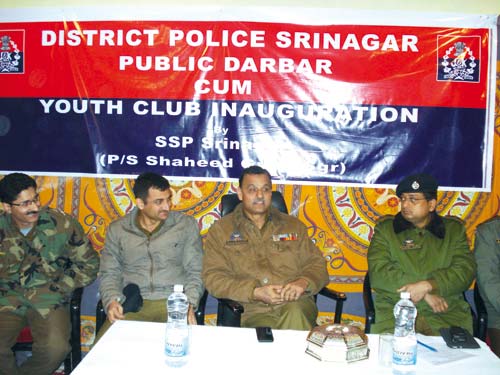
Through counseling and rehabilitation, the J&K police made an attempt to detach youth from stone-pelting, besides reforming their mindsets and cleaning its image among the general public. “The main aim was to adopt benign approach to handle the situation in valley. The crackdown on stone pelters on the basis of video-footage available with us further widened the police-public gap which had to be bridged,” the official said.
It was after 2010 protests that the best brains of Jammu and Kashmir police sat together and discussed various possibilities to control the street protests. And it was during these hectic and overdrawn discussions that the idea of setting up a rehabilitation policy was proposed, refined and finally implemented.
The J&K police’s Rehabilitation Policy is two pronged. While those who are arrested are being counseled by religious scholars and local clerics, the force is also setting up youth clubs in different parts of valley. To implement the new rehabilitation policy, the station house officers were directed to open the clubs in their areas soon after the 2010 unrest, the senior police official says. “In these clubs police would also interact with the youth to listen to their grievances,” he said.
One of the first youth clubs was opened in Nawhatta one year after the 2010 unrest broke out. On June 15, 2011, former Director General of Police, Kuldeep Khoda, arrived in the area along with Nasir Aslam Wani, the then Minister of State, Home, to inaugurate the club. Khoda termed the initiative as a resolve for the “prosperous future of the youth.”
On January 7, 2013, Deputy Inspector General of Police, Central Kashmir, Afad-ul-Mujtaba inaugurated a youth club at Kanitar, Sadderbal area of Srinagar. The youth club provides facilities like a gymnasium, indoor games, internet and library where students aiming for national level and state level competitive exams get the requisite study material and infrastructure to pursue their dreams.
A similar youth club was thrown open on February 4 this year when SSP Bukhari inaugurated a youth club in Srinagar’s Shaheed Gunj area. “I urge the participants to cooperate with the police in such matters as public assistance would strengthen efforts of police in dealing with such issues,” the SSP had said.
“The idea is to ‘simplify mind complexes’ in youth,” a high ranked police official in Srinagar’s District Police Lines revealed. “The policy categorizes stone pelters into three categories: A, B and C, based on their links with stone-pelting. Youth who figure in ‘A’ category have a history of stone pelting. Besides they are wanted by police for some time in other cases. ‘B’ category stone-pelters are not repeated offenders but figure on police radar while as ‘C’ category is comprised mostly of first timers,” he said.
Those who figure in the list of ‘A’ category usually face the stringent Public Safety Act (PSA) while as youth listed in B category are set free but asked to report at police station whenever stone-pelting happens in their area. ‘C’ category youth are usually being let off after counseling. All of them have to attend lectures on religion compulsorily.
It is not merely the categorization of stone pelters that makes the J&K police’s rehabilitation policy unique and appealing for the youth, most of who see police forces as ‘perpetrators’ of human rights violations that have taken place in Kashmir valley. “The main focus of the policy is to portray true image of Islam for youth, an image that advocates non-violence, communal harmony and brotherhood. During our course of investigation, we found many youth harbor extreme mindset against police in valley,” the official said. “I believe that there is always other side of the story which youth must understand. So we focus to enrich their minds with larger message of Islamic teachings to broaden their perspective on the state of affairs.”
On February 10, 2011, when the J&K police’s Rehabilitation Policy was still at its infancy stage, JKP claimed that 72 percent of 1000 youth arrested in Srinagar district for stone-pelting belong to broken families and a majority of them were drug addicts.
“We conducted our own survey on about the 1000 youth arrested for stone pelting in Srinagar district. We found that 72 percent have a background of broken families. Some are orphans and some have other problems. A majority of them, if not all, also have a history of drug addiction. We have held some camps for the youth with history of drugs. We have a full-fledged drug de-addiction centre functional for helping the youth to overcome the problems,” Syed Ashiq Hussain Bukhari, Senior Superintendent of Police, Srinagar, said.
















“A NICE AND A DETAILED PIECE, THE AUTHOR SHOULD HAVE TALKED TO OUR PRO-FREEDOM LEADERSHIP ON THIS TACTIC USED BY ENDIA”
First time in my life I have heard something good about Kashmir police. I know there are some good police men and officers. I have had the pleasure of seeing some good religious policemen and i am sure there must be many more but the bad apples are more prominent and morover, we in extreme passion and hatred paint every one with the same brush. Good people are always around otherwise the world would have come to an end by now.
Oh, dear god. Occupation is being strengthened by brainwashing kids. Torture us, detain us under no valid law and then make us call you ‘Saints’. Brilliant.
Release all youth from the age group 15-29 un-conditionally who have been arrested on stone pelting charges.
Allow Geelani and omer Farooq to offer their friday prayers in their respective and traditional masjids.
There is nothing good r bad abt police…their social responsibility role which has taken a fillip since few years is also a reactionary move 2 undo all those harms they inflicted on masses….i wud suggest them that rather than launching such a move they must inculcate more professional values among their men so that they dont deviate while performing their duties…..being an employee r being a stooge…..choice is theirs..